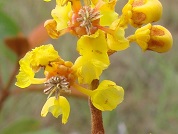Malpighiaceae from Colombia: Patterns of distribution, richness, endemism, and phylogenetic diversity
DOI:
https://doi.org/10.14522/darwiniana.2021.91.923Keywords:
Altitudinal gradient, Amazonia, Andes, Malpighiales, Neotropical floraAbstract
Malpighiaceae constitutes a family of 77 genera and ca. 1300 species, distributed in tropical and subtropical regions of both hemispheres. They are mainly diversified in the American continent and distributed in a wide range of habitats and altitudinal gradients. For this reason, this family can be a model plant group to ecological and biogeographical analyses, as well as evolutive studies. In this context, an analysis of distribution, richness, endemism and phylogenetic diversity of Malpighiaceae in natural regions and their altitudinal gradients was undertaken. Malpighiaceae are represented in Colombia by 34 genera and 246 species (19.1% of endemism). Thus, Colombia and Brazil (44 genera, 584 species, 61% of endemism) are the two richest countries on species of this family. The highest species richness and endemism in Colombia is found in the lowlands (0-500 m a.s.l.: 212 species, 28 endemics); only ten species are distributed on highlands (2500-3200 m a.s.l.). Of the Malpighiaceae species in Colombia, Heteropterys leona and Stigmaphyllon bannisterioides have a disjunct amphi-Atlantic distribution, and six other species show intra-American disjunctions. Both richness and endemism decrease with altitude (y = -0.061x + 173.57; R2 = 0.82; y = -0.009x + 27.76; R2 = 0.95, respectively). Amazonia (116 species, 4 endemics) and the Andes (89 species, 23 endemics) exhibit the highest richness among the family. In Colombia, 15 of the 19 clades among the family are represented, where the most diversified are the Stigmaphyllon clade (5 genera, 48 species, 10 endemics), the Byrsonima clade (3/39/5) and the Hiraea clade (3/31/9). The relationship of phylogenetic diversity with altitude is similar to the pattern of specific richness by altitudinal interval. Amazonia, Orinoquia, and Magdalena Valley show highest phylogenetic diversity. These results, combined with those of other highly diversified biological groups in the country, could be important to define and delimitate new priority areas for conservation in Colombia.

Downloads
Published
How to Cite
Issue
Section
License

Starting on 2012, Darwiniana Nueva Serie uses Licencia Creative Commons Atribución-NoComercial 2.5 Argentina .





